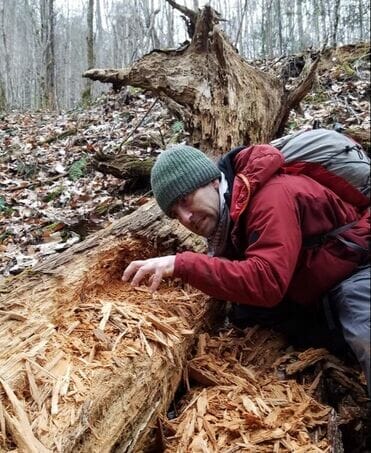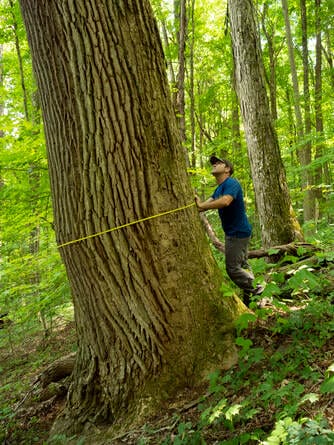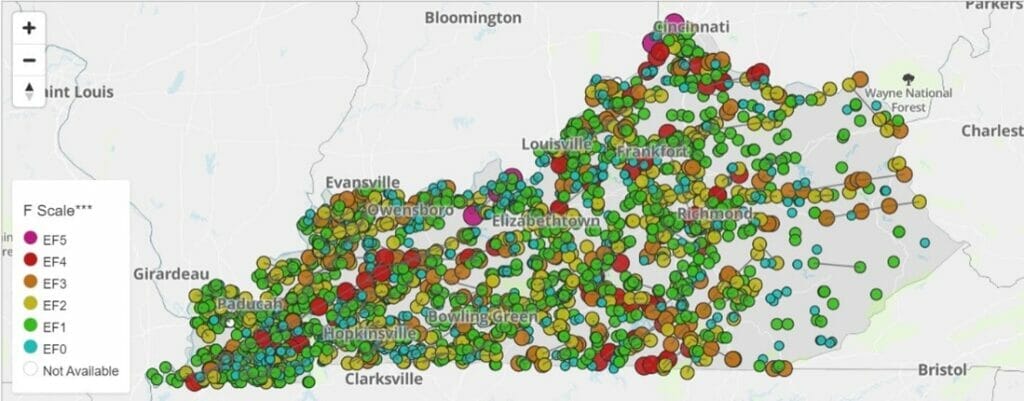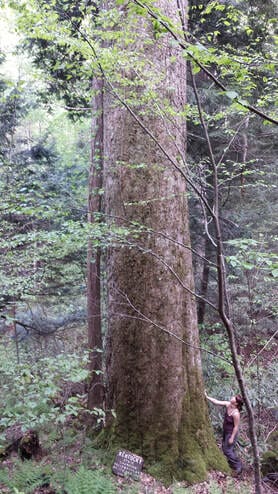How much old-growth is there in the Daniel Boone National Forest? This is actually a pretty tough question to answer. The short answer is “not much.” But before we can dig in and try to answer that first question, we need to ask another: What is old-growth?
The term “old-growth,” or “old-growth forest,” is often used as a broad, catchall label describing any forest with big or old trees. It can also be a highly technical designation with specific attributes and near-countless variations. In the broadest sense, old-growth forests exhibit structural characteristics that require long periods of without major, stand-replacing disturbance. Usually, this means a forest with trees that are large and old (relative to the site and species present), and with a complex structure. The specific structural characteristics, and the time required for them to develop, can vary considerably for different forest types and regions. For example, old-growth trees on dry ridge sites can be quite small, while trees of similar age just downslope on sites with deeper soils and more water availability can be massive.
For the purposes of this article, we’re going to narrow our scope to the deciduous forests of eastern North America, and more specifically to those forest communities found in the Daniel Boone National Forest.


Forest Structure and Disturbance
The structure of a forest at any given point in time is a result of the dynamic and ongoing interplay between the growth of trees and the death of trees. The death of trees is an integral part of ecosystem functioning. Trees are killed through a variety of natural disturbances, including wind, ice, fire, pathogens, beavers, and other processes. And the patterns by which trees die can vary dramatically over space and time.
Tree damage from ice storms, for example, can result in a lengthy, uneven decline of trees scattered across the landscape, with particular landscape positions and tree species (like maples and tulip poplar) being more susceptible to ice damage. A line of thunderstorms might result in individual and small groups of trees being blown down across a large area, while a microburst from that same storm system could level all of the trees in a one- or two-acre patch. A wildfire during drought conditions may burn hot, leaving only the most fire-tolerant trees like shortleaf and pitch pine alive. And yet a lower-intensity fire will mostly damage thin-barked trees, like American beech and red maple, leaving them to decline slowly over time.
The predominant types of natural disturbance that shape the forests of eastern Kentucky are of small to intermediate scale and intensity and occur with relatively high frequency. “Stand replacing” natural disturbance events (or “regeneration” events), which kill most trees at larger scales (10s to 100s of acres), like tornados and derechos, are highly impactful but very uncommon. The death of trees can result in immediate changes in a forest’s structure but also cause long-term changes in forest processes and species composition, known as “ecological legacies,” that play out over decades or centuries.

While symbiotic relationships are increasingly recognized as important in forest ecosystems, competition for sunlight remains a predominant factor in forests’ structure and function. And when trees die, surviving neighbors and understory trees often benefit from the increased sunlight and available soil moisture which, in turn, allows them to increase in vigor and growth.
When a canopy gap created by a dead tree or trees is small, adjacent canopy trees will fill in the gap through lateral branch growth. When a gap is so large that the surrounding canopy trees can’t close the gap, the result is a new patch of young forest and dense vegetation (also called early seral habitat) within the older forest matrix.

Models of Forest Development
Classical models of forest development describe four structural stages beginning with a stand-replacing disturbance. The “stand initiation” stage, lasting about 10 years, is characterized by brushy, dense vegetation. The forest then enters the “stem exclusion” stage, with large numbers of densely packed trees and an even-height (codominant) canopy. Competition among the densely growing trees causes some trees to die. As the total number of trees decreases, the size (and volume) of living trees increases.
Somewhere around 60 to 80 years after stand initiation (the threshold is debatable), forests transition into the “stand reinitiation” or “demographic transition” stage. This is the predominant structural stage of most “mature” secondary forests in the Daniel Boone. During this stage trees can be tall, but the canopy is still mostly in a “codominant” arrangement where the upper canopies are all about the same height with a limited number of small gaps allowing light through an otherwise closed-canopy. At this point younger trees may start to show up in the understory.
By around 120 to 150 years, the combination of tree growth and the death of individual and small groups of trees leads to the major structural changes associated with the “old-growth” or “old multi-age” stage of forest development. Some trees have grown very large, with dominant canopies positioned above the prevailing codominant canopy. Large canopy gaps have allowed for the development of small patches of younger trees of various ages. The forest has more large snags, den trees, and down wood. Overall, the forest is much more structurally complex than younger and mature forests.

And Here’s Where It Gets Really Complicated…

Small and intermediate scale natural disturbances help to drive old-growth forest structure, while disturbances at larger scales and intensities can act as stand-initiating events that “reset” a forest. But even severe natural disturbances usually leave some trees standing. Tree ring data from old-growth forests reveal patterns of both small-scale (asynchronous) disturbances and larger (synchronous) disturbance events. In the latter case, enough older trees survive so that the forest is still considered “old-growth,” but sufficient canopy was removed to allow for the establishment of young trees (a new “age class”) scattered across the site.
Drawing the line between intermediate disturbance and a stand-replacing disturbance, and the effects on old-growth status, isn’t always clear.
But wait! It can get even more complicated! Over centuries, a forest may be subject to a variety of disturbance events with differing effects, at different times, and at different scales. The result can be very complex legacies that defy the simpler models of forest development, and which can only be teased out through detailed study and examination of tree ring patterns and structural data. For practical reasons, that level of investigation has been relegated to just a handful of places. But the information gleaned can help us make better informed assessments based on the data and observations that we do have.
Can We Make This Simple, Please?
Yes.
A forest can be considered old-growth – from an ecological perspective – where a meaningful number of trees meet a particular age threshold and when the forest exhibits some of the structural characteristics discussed above. The specific numbers depend on the type of forest community and can be debated.
The Forest Plan for the Daniel Boone National Forest incorporates the Forest Service’s 1997 “Guidance for Conserving and Restoring Old-Growth Forest Communities on National Forests in the Southern Region.” The Guidance does a pretty good job of simplifying old-growth definitional criteria for a wide range of forest types found in the southeast and Kentucky. Those criteria start with a minimum age of the oldest age class, and then follow up with a few other criteria (tree size, number of trees, and extent of human modifications). The predominant forest types on the Daniel Boone are considered potential old-growth if the “oldest age class” is over 130 years old, though depending on forest type that threshold can range from 100 to 140 years.
The age thresholds in the Forest Service’s Guidance are reasonable approximations of when forests develop old-growth characteristics and leave room for both “primary” and “secondary” old-growth. Primary old-growth is old-growth forest that has had no (or minimal) human-caused disturbance (like logging), while secondary old-growth is forest that was mostly logged but has had enough time to recover its old-growth characteristics. There is very little primary old-growth in the Daniel Boone, but a large amount of mature forest is poised to transition into a secondary old-growth condition. Some of the more interesting sites are essentially secondary old-growth forests, but where a modest number of primary old-growth trees survived and contribute to both ecology and aesthetics.
So How Much Old-Growth Is There in The Daniel Boone National Forest?
The Forest Service divides the Daniel Boone National Forest into over 27,000 inventoried “stands” of about 20 to 70 acres and assigns a “stand age” to most of these units. Unfortunately, the Forest Service’s age data are highly unreliable for older forests, with notable cases of important old-growth being misclassified as younger forest. Still, these data show about 46,000 acres, or 6.5%, of the Daniel Boone being over 130 years and potentially being old-growth. Only 967 acres are inventoried as being over 200 years old, representing just 0.1% of the Daniel Boone. A lot of this older forest is eastern hemlock forest, which is in sharp decline due to the invasive hemlock woolly adelgid.


Another approach to estimating the amount of old-growth in the Daniel Boone was recently conducted by the U.S. Departments of Agriculture and Interior. Called “the first-ever initial inventory” of mature and old-growth (MOG) forests on lands administered by the U.S. Forest Service and Bureau of Land Management (BLM), this analysis was conducted in response to President Biden’s 2022 Executive Order on Strengthening the Nation’s Forests, Communities, and Local Economies (E.O. 14072).
The report found that the Daniel Boone has a “low” amount of old-growth and “intermediate” amount of mature forest. A navigable map displaying data from the MOG inventory can be found online. However, it’s important to be clear about what this inventory actually tells us.
The inventory is based on data collected through the U.S. Forest Service’s Forest Inventory and Analysis (FIA) program. Under that program, all forested areas in the U.S. (public and private) are divided into 6,000-acre hexagons, each with a single, permanently established FIA plot. These plots are remeasured every 5-10 years, depending on what region they are in. The FIA data provide a wealth of information on regional and continental-scale forest trends. However, the data are very coarse and therefore limited – even useless – for local-scale analyses.
For the MOG inventory, various measurements captured in the FIA data were associated with “old-growth” and “mature” forest conditions. Plots were then aggregated across 250,000-acre “firesheds” to represent the amount of mature and old-growth forests at a scale with reasonable statistical reliability. The data tell us something about the amount of old-growth on the Daniel Boone, but not very much.
An independent study by Barnett and others, published in 2023, used a more compelling methodology to assess the amount of mature and old-growth forests in North America, but unfortunately does not break out Kentucky forests or the Daniel Boone. However, for the Oak/hickory forest type region (which covers most of Kentucky, Tennessee, parts of West Virginia, and the Missouri and Arkansas Ozarks), the authors estimated that only 0.62% of the forest was old-growth, with 44.88% of forest being “Mature,” 19.99% “Young,” and 34.51% “Early seral.”
Where to Find Old-Growth in the Daniel Boone National Forest
Seeing old-growth is awesome.
Small patches of primary old-growth are scattered across the Daniel Boone. But a lot of our best old-growth is difficult to access or in sensitive areas requiring some level of conservatism in sharing information.

Most of our primary old-growth falls into two categories. The first consists of productive forests nestled below clifflines, especially in narrow ravines. These are usually hemlock and mixed mesophytic forests. Eastern hemlock, tulip poplar, white oak, yellow buckeye, pignut hickory, and cucumber magnolia are some of the more common tree species, but these are highly diverse forests. Trees in these locations can get very large, but were likely spared from logging when the costs of accessing the timber outweighed their economic return.
The most notable of these sites are Rock Creek Research Natural Area and Tight Hollow proposed Research Natural Area. Rock Creek has been the subject of several studies, including a botanical survey and an examination of old-growth characteristics using tree ring and other data. Little research has been carried out in Tight Hollow, largely due to access issues. Permitted tree coring in Tight Hollow by this author identified trees over 300 years old, including two tulip poplars that are over 400 years old. Other pockets of this old-growth type are scattered throughout the Daniel Boone, especially in places like Beaver Creek and Clifty Wilderness Areas, Cane Creek, Angel Hollow, and other places with abundant and rugged cliffline.
The other main category of primary old-growth is represented by dry forests on ridges. Trees in these forests rarely get large and are typically gnarly and of short stature – characteristics which probably kept them from getting cut. Chestnut oak, white oak, black gum, and shortleaf and pitch pines tend to be the oldest trees (reaching over 300 years), though it’s not unusual to find old hickories and tulip poplar. Without a discerning eye it can be easy to miss these forests. Kentucky Heartwood has documented outstanding forests of this type in the South Red Bird project area, most notably in the Elisha Creek watershed. Kentucky Heartwood is suing the Forest Service over their decision to log some of these locations, in part due to the agency’s mischaracterization of them as younger forests.
Over time we will lose these higher quality and primary old-growth sites. Whether it’s hemlock woolly adelgid or federal timber sales, or any of the natural disturbances discussed above, these old-growth forests will not last forever. However, there is a significant amount of mature forest across the Daniel Boone that is poised to become old-growth over the coming decades. These future old-growth forests will, in some ways, be different from the old-growth of the past. But if preserved and managed with care, they present a tangible opportunity to recover some of the wild grandeur of Kentucky historic old-growth forests.
– Jim Scheff, Ecologist


